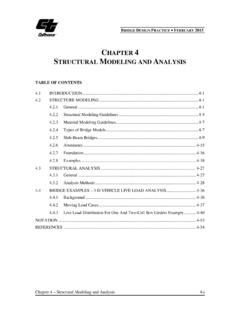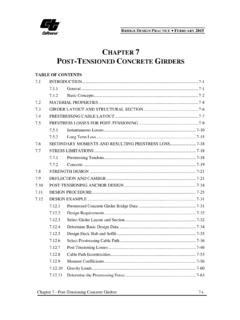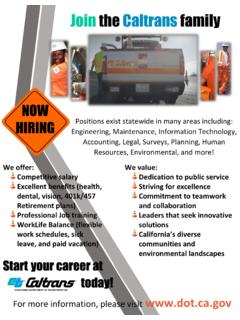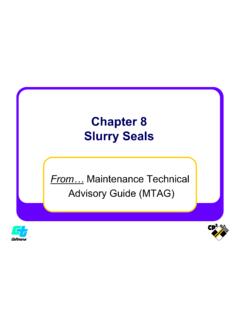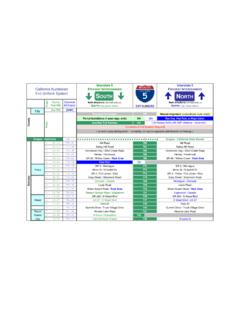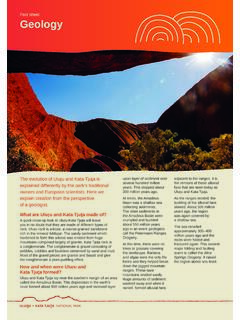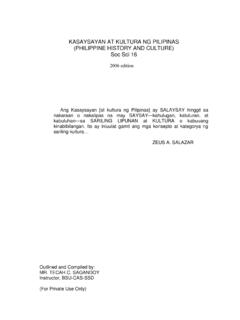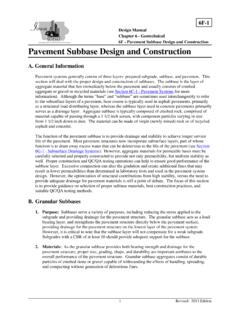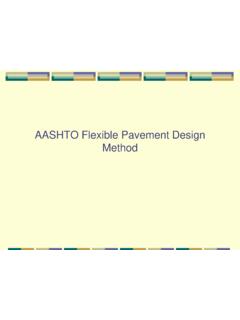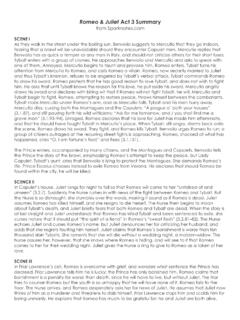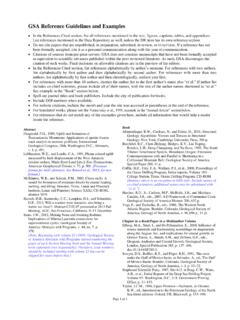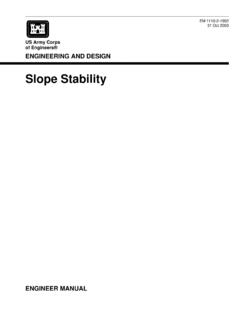Transcription of CONCRETE PAVEMENT GUIDE - California Department of ...
1 State of California Department of Transportation CONCRETE PAVEMENT GUIDE Division of Maintenance PAVEMENT Program 5900 Folsom Boulevard, MS-5 Sacramento, CA 95819 January 2015 CONCRETE PAVEMENT GUIDE Division of Maintenance PAVEMENT Program Blank January 2015 CONCRETE PAVEMENT GUIDE Division of Maintenance PAVEMENT Program Disclaimer January 2015 DISCLAIMER The contents of this GUIDE reflect the views of the authors who are responsible for the facts and accuracy of the data presented herein.
2 The contents do not necessarily reflect the official views or policies of the State of California or the Federal Highway Administration. This GUIDE does not constitute a standard, specification, or regulation. CONCRETE PAVEMENT GUIDE Division of Maintenance PAVEMENT Program Preface January 2015 PREFACE The CONCRETE PAVEMENT GUIDE (CPG) provides a comprehensive overview of current new construction-reconstruction, preservation, and rehabilitation strategies used by the Department for CONCRETE PAVEMENT . The information in this GUIDE applies to all CONCRETE PAVEMENT and composite PAVEMENT that was not previously cracked and seated.
3 Some of these topics were previously addressed in the Maintenance Technical Advisory GUIDE (MTAG). The CPG reflects updated Caltrans CONCRETE PAVEMENT practices, including effectiveness and limitations; strategy and materials selection; design issues; and implementation of the revised 2010 construction contract standard plans, specifications, and bid items for individual PAVEMENT strategies. The CPG assists district design, maintenance, and materials personnel with CONCRETE PAVEMENT project delivery by supplementing the information and design standards contained in Highway Design Manual (HDM) Chapters 600-670.
4 Some relevant CONCRETE PAVEMENT construction information is included in the CPG, but the Construction Manual should be referenced for more comprehensive information about specific constructionprocedures. The CONCRETE PAVEMENT GUIDE is divided into 19 topical chapters organized into 4 parts: Part 1 provides general information and an overview of CONCRETE PAVEMENT strategies and evaluation; Part 2 covers new CONCRETE PAVEMENT and reconstruction strategies; Part 3 preservation strategies; and Part 4rehabilitation strategies.
5 Some chapters are reserved for future development. CONCRETE PAVEMENT GUIDE Division of Maintenance PAVEMENT Program Blank January 2015 CONCRETE PAVEMENT GUIDE Division of Maintenance PAVEMENT Program Table of Contents January 2015 i CONCRETE PAVEMENT GUIDE PART 1: GENERAL INFORMATION Section Title Page Number CHAPTER 100 PAVEMENT MANAGEMENT STRATEGIES PAVEMENT MANAGEMENT CONCEPTS 100-1 Network-level PAVEMENT Management 100-2 Optimal Project Timing 100-3 PROJECT-LEVEL CONCRETE PAVEMENT STRATEGIES 100-4 New Design Strategies 100-4 Preservation Strategies 100-4 Rehabilitation Strategies 100-6 CONCRETE PAVEMENT PROJECT IMPLEMENTATION 100-7 PAVEMENT Strategy Recommendations 100-8 Strategy Combinations and Preoverlay
6 Repair 100-11 CHAPTER 110 STRATEGY EVALUATION STRATEGY EVALUATION PROCESS 110-1 STEP 1: EVALUATE EXISTING CONDITIONS 110-3 faulting Mechanism Analysis 110-6 Evaluating Base Condition 110-7 STEP 2: PERFORMANCE LIFE EXPECTANCY 110-3 STEP 3: FEASIBILITY ANALYSIS 110-8 Cost Analysis 110-9 STEP 4: STRATEGY SELECTION 110-10 Documenting PAVEMENT Recommendations (Typical Outline) 110-11 REFERENCES 110-11 CHAPTER 120 PAVEMENT DESIGN AND MATERIALS PAVEMENT DESIGN 120-1 Climate 120-1 Traffic Loading 120-3 CONCRETE PAVEMENT Structures 120-3 MATERIALS 120-6 CONCRETE Materials 120-6 Roller Compacted CONCRETE (RCC)
7 120-9 CONCRETE Repair Materials and Specifications 120-10 Joint and Crack Seal Materials 120-13 OTHER CONSIDERATIONS 120-13 CONCRETE PAVEMENT GUIDE Division of Maintenance PAVEMENT Program Table of Contents January 2015 ii Section Title Page Number PAVEMENT Drainage 120-13 Load Transfer 120-14 Maintainability 120-16 Constructability 120-16 Cost Estimating 120-19 REFERENCES 120-19 PART 2: NEW OR RECONSTRUCTION STRATEGIES CHAPTER 200 CONTINUOUSLY REINFORCED CONCRETE PAVEMENT (CRCP)
8 PURPOSE AND DESCRIPTION 200-1 Benefits 200-2 Limitations 200-2 MATERIALS AND PLACEMENT 200-2 CONCRETE 200-2 Bar Reinforcement 200-3 Joints 200-3 JOINTS 200-4 Transverse Construction Joints 200-5 Longitudinal Construction Joints 200-5 Longitudinal Contraction Joints 200-6 TERMINAL JOINTS, PAVEMENT TRANSITIONS, AND END ANCHORS 200-7 Terminal Joints 200-7 Expansion Joints 200-8 Wide Flange Beam Terminal Joints 200-9 PAVEMENT End Anchors 200-10 PAVEMENT End Transitions 200-11 DESIGN 200-11 Performance 200-11 PAVEMENT Structure Layers 200-12 Shoulders 200-12 Temporary CRCP Gaps During Construction 200-13 Standard Plans 200-13 Standard Specifications 200-15 Cost Estimating 200-15 REFERENCES 200-16 CONCRETE PAVEMENT GUIDE
9 Division of Maintenance PAVEMENT Program Table of Contents January 2015 iii Section Title Page Number CHAPTER 210 JOINTED PLAIN CONCRETE PAVEMENT (JPCP) JPCP COMPONENTS 210-1 CONCRETE 210-2 Joints 210-2 Base Bond Breaker 210-4 Tie Bars 210-4 Load Transfer and Dowel Bars 210-5 OTHER JPCP CONSIDERATIONS 210-6 Widening 210-6 Widened Lanes with HMA Shoulders 210-6 Narrow Shoulders 210-7 PAVEMENT Transitions 210-7 CONCRETE Barrier in CONCRETE Medians 210-7 CONCRETE PAVEMENT Over Culverts 210-8 Stage Construction 210-8 PLANS, SPECIFICATIONS.
10 AND ESTIMATING 210-8 Standard Plans 210-9 Standard Special Provisions (SSPs) 210-10 Cost Estimating 210-10 CHAPTER 220 PRECAST PANEL CONCRETE PAVEMENT Future Development PART 3: PRESERVATION STRATEGIES CHAPTER 300 SUBSEALING AND JACKING Future Development CHAPTER 310 SPALL REPAIR PURPOSE AND DESCRIPTION 310-1 Spall Repair Applications and Limitations 310-1 MATERIALS AND SPECIFICATIONS 310-2 Polyester CONCRETE 310-3 Fast-Setting CONCRETE 310-3 Bonding Agents 310-4 Other Repair Material Types 310-4 DESIGN 310-4 Order of Work 310-5 CONCRETE PAVEMENT GUIDE Division of Maintenance PAVEMENT Program Table of Contents January 2015 iv
